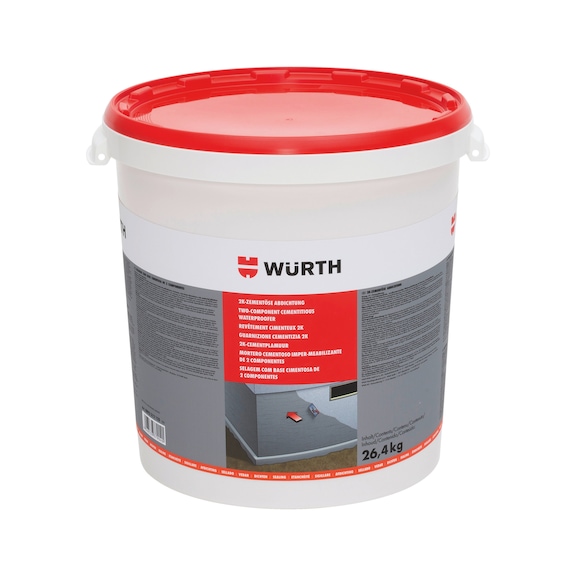For detailed information, other images and documents, please select individual articles from the following table.
2-component cement-based sealant
Polystyrene- and bitumen-free two-component cement/plastic-based surface sealant.
Register now and access more than 125,000 products
Variants
Register now and access more than 125,000 products
Material basis: Cement and polymer additive
- Solid surface, which provides mechanical and chemical protection of walkable concrete surfaces (not suitable for horizontal silos or similar structures)
- Cures quickly and definitively, thereby speeding up work
- Does not blister on warm surfaces
- Outstanding friction adhesion on mineral surfaces, high degree of functionality
Bitumen- and polystyrene-free
- No bitumen seepage
- Good UV stability, making it ideal for sealing in visible areas (e.g. sockets with a plaster layer)
- No loss of layer thickness under pressure, high degree of functional reliability
Elastic material behaviour
Remains permanently flexible and bridges cracks, guaranteeing a high degree of functionality
Resistant to all standard chemically aggressive media encountered in floors, as well as diluted acids and lyes that attack concrete
Solvent-free
The minimum application temperature is +5 °C. It is essential that the layer does not come into contact with the effects of rain, frost or water pressure until both layers are completely dry. Discolouration cannot be ruled out with long-term exposure to sunlight, which should therefore be avoided. Not for use in horizontal silos, biogas installations and similar systems. Not suitable for water entering from behind or for sealing roofs. During application, it is recommended that you wear personal protective equipment (safety goggles, art. no. 0892 102 ff./gloves, article no. 0899 435 ff.). The powder component contains cement, therefore avoid contact with skin.
Guaranteed radon-proof according to Radio Ökologisches Institut Keller
The usage instructions are recommendations based on the tests we have conducted and our experience. Conduct your own tests prior to any use. Due to the large number of applications and storage and processing conditions, we do not assume any liability for a specific application result. If our free customer service provides technical information or advice, no liability is accepted except when the advice given or the information provided falls within the scope of our specified, contractually agreed service or where the adviser acted intentionally. We guarantee that our products are always of the highest quality. We reserve the right to carry out technical amendments and develop our products further.
2-component cement-based sealant is used in the Würth construction sealing system for elastic and watertight sealing of areas at risk of cracks and of terraces and balconies that are not positioned above living spaces, for protecting concrete surfaces intended for foot traffic, for sealing water reservoirs (not drinking water), swimming pools and wet and moist spaces, and for transverse seals in accordance with W4-E. Not suitable for water that penetrates from behind or for sealing roofs.
For use in accordance with DIN 18533, section 3, table 1, regulations 3 and 4, "Crack-bridging mineral sealant (MDS)", for use on concrete substrates for water shock classes W1-E and W4-E.
The substrate must be dry to lightly moist and free from grease, oil, frost, tar and bitumen. Non-absorbent substrates must first be moistened so that they are moderately damp. Puddles must be avoided, however. Absorbent substrates must be primed with waterproofing system primer coat (art. no. 0893 212 100) to improve the adhesion. Loose components and protruding mortar residues must be removed before work is begun. Sharp edges must be blunted and corner and transition areas must be rounded off by means of a chamfer with waterproof mortar (art. no. 0893 212 110). Compensate recesses > 5 mm with waterproof mortar, art. no. 0893 212 110. Mix the entire liquid component (bag is placed in bucket) in portions into the powder component with a slow stirrer, article no. 0702 836, or a mixing rod, article no. 0713 95 121. Carefully and thoroughly mix both materials until they form a lump-free, homogeneous paste. A universal brush, article no. 0693 009 5, or a smooth comb, article no. 0695 943 ff., is used to apply "2-component cement-based sealant" in two layers; the first layer must be cured before the second layer is applied. At locations at risk of cracking, reinforcement mesh (article no. 08963 212 105) must be laid in the first substrate layer. On adjacent components (floor panels or similar structures), the seal must be applied to at least 15 cm from the front edge. At all points, a horizontal seal must be included in the sealing of the substrate.
Select RAL-colour code
!! NOTE: On-screen visualisation of the colour differs from real colour shade!!



